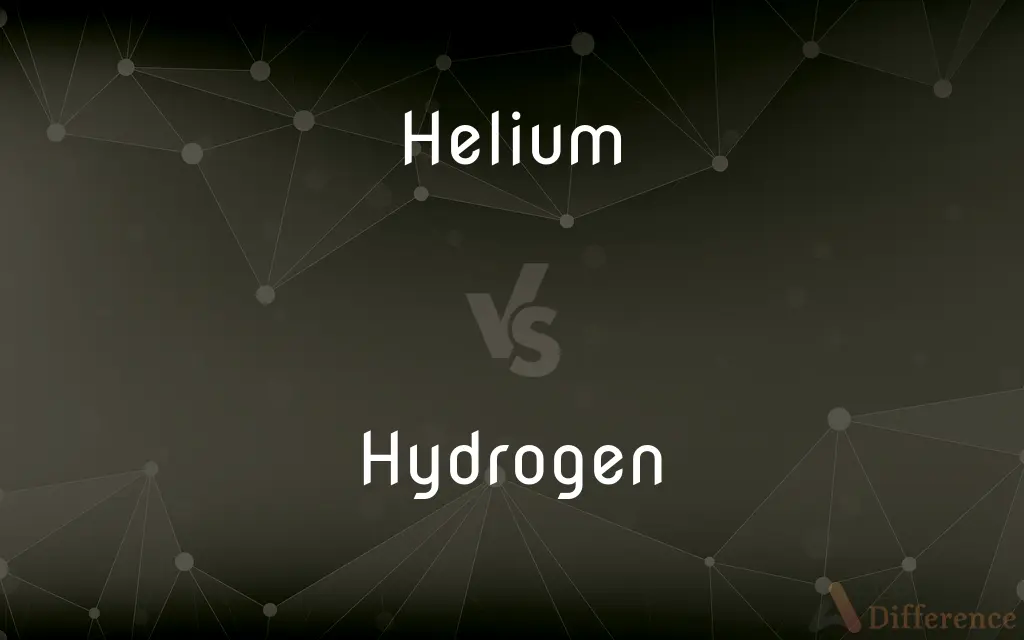Helium vs. Hydrogen — What's the Difference?
Edited by Tayyaba Rehman — By Fiza Rafique — Updated on October 6, 2023
Helium is an inert, non-flammable gas with atomic number 2, while Hydrogen is a flammable gas with atomic number 1.

Difference Between Helium and Hydrogen
Table of Contents
ADVERTISEMENT
Key Differences
Both Helium and Hydrogen are elements found in the periodic table, but they differ significantly in terms of properties and uses. Helium, with atomic number 2, is a noble gas, which means it's largely inert and does not readily form compounds with other elements. Its non-reactive nature makes Helium ideal for uses like cooling superconducting magnets. Conversely, Hydrogen, possessing atomic number 1, is the lightest and most abundant element in the universe. It easily combines with other elements, resulting in compounds like water.
While Helium is commonly known for its role in inflating balloons, Hydrogen, due to its reactivity, has the potential for use in fuel cells.
When considering their role in the universe, Hydrogen is fundamental in the formation of stars, whereas Helium is produced as a result of nuclear fusion in stars.
Thus, while both Helium and Hydrogen play crucial roles in science and industry, they differ in reactivity, abundance, and applications.
Comparison Chart
Atomic Number
2
1
ADVERTISEMENT
Reactivity
Largely inert.
Highly reactive.
Common Uses
Cooling, inflating balloons.
Fuel, water formation.
Occurrence in Stars
Product of nuclear fusion.
Fundamental in star formation.
Flammability
Non-flammable.
Flammable.
Compare with Definitions
Helium
A noble gas in the periodic table.
Helium is used to inflate party balloons.
Hydrogen
A chemical element with atomic number 1.
Hydrogen is a major component of water.
Helium
A non-reactive gas.
Due to its inert nature, Helium doesn't form many compounds.
Hydrogen
The lightest and most abundant element.
Hydrogen fuels the sun through nuclear fusion.
Helium
An element with atomic number 2.
Helium has two electrons in its outermost shell.
Hydrogen
A flammable gas.
Hydrogen gas is used in rocket propulsion because of its flammability.
Helium
Lighter than air, but heavier than Hydrogen.
Helium-filled balloons rise because the gas is lighter than air.
Hydrogen
Capable of forming a diatomic molecule, H2.
Hydrogen gas in nature primarily exists as H2.
Helium
Used in cryogenics and cooling.
MRI machines use liquid Helium for cooling purposes.
Hydrogen
Hydrogen is the chemical element with the symbol H and atomic number 1. Hydrogen is the lightest element in the periodic table.
Helium
Helium (from Greek: ἥλιος, romanized: helios, lit. 'sun') is a chemical element with the symbol He and atomic number 2. It is a colorless, odorless, tasteless, non-toxic, inert, monatomic gas, the first in the noble gas group in the periodic table.
Hydrogen
A colorless, highly flammable element, that occurs as a diatomic molecule, H2, the lightest of all gases and the most abundant element in the universe, used in the production of synthetic ammonia and methanol, in petroleum refining, in the hydrogenation of organic materials, as a reducing atmosphere, in oxyhydrogen torches, in cryogenic research, and in rocket fuels. Atomic number 1; atomic weight 1.00794; melting point -259.1°C; boiling point -252.8°C; density at 0°C 0.08988 gram per liter; valence 1. See Periodic Table.
Helium
A colorless, odorless inert gaseous element occurring in natural gas and with radioactive ores. It is used as a component of artificial atmospheres and laser media, as a refrigerant, as a lifting gas for balloons, and as a superfluid in cryogenic research. Atomic number 2; atomic weight 4.0026; boiling point -268.9°C; density at 0°C 0.1785 gram per liter. See Periodic Table.
Hydrogen
The lightest chemical element (symbol H), with an atomic number of 1 and atomic weight of 1.00794. Category:en:Hydrogen
Helium
(uncountable) The second lightest chemical element (symbol He) with an atomic number of 2 and atomic weight of 4.002602, a colorless, odorless and inert noble gas. Category:en:Helium
Hydrogen
An atom of the element.
Helium
(countable) A form or sample of the element.
Hydrogen
Molecular hydrogen (H2), a colourless, odourless and flammable gas at room temperature.
Helium
An inert, monoatomic, gaseous element occurring in the atmosphere of the sun and stars, and in small quantities in the earth's atmosphere, in several minerals and in certain mineral waters. It is obtained from natural gas in industrial quantities. Symbol, He; atomic number 2; at. wt., 4.0026 (C=12.011). Helium was first detected spectroscopically in the sun by Lockyer in 1868; it was first prepared by Ramsay in 1895. Helium has a density of 1.98 compared with hydrogen, and is more difficult to liquefy than the latter. Chemically, it is an inert noble gas, belonging to the argon group, and cannot be made to form compounds. The helium nucleus is the charged particle which constitutes alpha rays, and helium is therefore formed as a decomposition product of certain radioactive substances such as radium. The normal helium nucleus has two protons and two neutrons, but an isotope with only one neutron is also observed in atmospheric helium at an abundance of 0.013 %. Liquid helium has a boiling point of -268.9° C at atmospheric pressure, and is used for maintaining very low temperatures, both in laboratory experimentation and in commercial applications to maintain superconductivity in low-temperature superconducting devices. Gaseous helium at normal temperatures is used for buoyancy in blimps, dirigibles, and high-altitude balloons, and also for amusement in party balloons.
Hydrogen
A molecule of this molecular species
Helium
A very light colorless element that is one of the six inert gasses; the most difficult gas to liquefy; occurs in economically extractable amounts in certain natural gases (as those found in Texas and Kansas)
Hydrogen
A sample of the element/molecule.
Hydrogen
A gaseous element, colorless, tasteless, and odorless, the lightest known substance, being fourteen and a half times lighter than air (hence its use in filling balloons), and over eleven thousand times lighter than water. It is very abundant, being an ingredient of water and of many other substances, especially those of animal or vegetable origin. It may by produced in many ways, but is chiefly obtained by the action of acids (as sulphuric) on metals, as zinc, iron, etc. It is very inflammable, and is an ingredient of coal gas and water gas. It is standard of chemical equivalents or combining weights, and also of valence, being the typical monad. Symbol H. Atomic weight 1.
Hydrogen
A nonmetallic univalent element that is normally a colorless and odorless highly flammable diatomic gas; the simplest and lightest and most abundant element in the universe
Hydrogen
Potential fuel source in fuel cells.
Researchers are exploring Hydrogen as a clean energy alternative.
Common Curiosities
Why is Hydrogen considered as a potential future fuel?
Hydrogen can produce energy when combined with oxygen, emitting only water as a byproduct.
Is Hydrogen present in water?
Yes, water consists of two Hydrogen atoms bonded to one oxygen atom.
Is Helium reactive?
No, Helium is largely inert and doesn't react easily.
How is Hydrogen used in the sun?
The sun's energy comes from nuclear fusion, where Hydrogen atoms fuse to form Helium.
Can you breathe in Helium?
While inhaling Helium can change voice pitch temporarily, it's dangerous as it deprives the body of oxygen.
Can you store Helium indefinitely?
No, Helium atoms can escape most containment over time due to their small size.
Is Helium abundant on Earth?
No, while Helium is the second most abundant element in the universe, it's relatively rare on Earth.
Why is Hydrogen flammable?
Hydrogen has a high affinity for oxygen and releases energy when they combine, making it flammable.
Which is lighter, Helium or Hydrogen?
Hydrogen is lighter than Helium.
Why do Helium-filled balloons float?
Helium is lighter than air, causing balloons filled with it to rise.
How is Hydrogen produced for industrial uses?
Hydrogen is often produced through processes like steam reforming of natural gas or electrolysis of water.
Are Helium and Hydrogen the lightest elements?
Yes, Hydrogen is the lightest, followed by Helium.
Is it possible to run cars on Hydrogen?
Yes, Hydrogen fuel cells can power vehicles, producing only water as exhaust.
Is Hydrogen safe for transportation?
Hydrogen requires special safety measures due to its flammability and pressure considerations during transportation.
Why is Helium used in MRI machines?
Helium, when cooled to a liquid state, is used to cool the superconducting magnets in MRI machines.
Share Your Discovery

Previous Comparison
Fog vs. Mist
Next Comparison
Radar vs. SonarAuthor Spotlight
Written by
Fiza RafiqueFiza Rafique is a skilled content writer at AskDifference.com, where she meticulously refines and enhances written pieces. Drawing from her vast editorial expertise, Fiza ensures clarity, accuracy, and precision in every article. Passionate about language, she continually seeks to elevate the quality of content for readers worldwide.
Edited by
Tayyaba RehmanTayyaba Rehman is a distinguished writer, currently serving as a primary contributor to askdifference.com. As a researcher in semantics and etymology, Tayyaba's passion for the complexity of languages and their distinctions has found a perfect home on the platform. Tayyaba delves into the intricacies of language, distinguishing between commonly confused words and phrases, thereby providing clarity for readers worldwide.














































